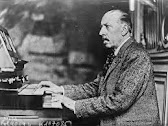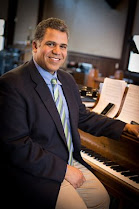This Sunday, I’ll be offering Liszt’s monumental Prelude and Fugue on B-A-C-H at the prelude.
The first time I heard this piece was at the 2024 AGO National Convention in the stunning Cathedral of Christ the Light, in San Franscisco, California, and I was completely amazed and inspired by its complexity, power, and thrilling energy. The performance was by Dong-ill Shin, Organ Professor at Yonsei University in Seoul, Korea, whom I have included a picture of.
After returning home, I devoted the following year to studying this masterpiece in depth, spending countless hours analyzing, practicing, and exploring how to bring its many colors and emotions to life. Through coaching sessions and experimentation, I sought to shape the sound in a way that captures the work’s mysterious atmosphere, its overwhelming grandeur, and its exhilarating spirit.
This piece has been both a challenge and an inspiration, and I’m deeply excited to share it with you this Sunday.
Franz Liszt's Fantasy and Fugue on B-A-C-H (S. 529) takes the notes B-A-C-H and builds a complex musical structure based on this simple musical motif (In German music notation, B natural is written as “H” and B-flat as “B”).The composition features an overt spelling of B-A-C-H in the pedals at the beginning and develops it through elaborate harmonies and scales. The piece uses both the traditional forms of fantasy and fugue, but Liszt infuses them with his signature virtuosity and harmonic innovation, making it a unique and challenging work that blends homage to Bach with Liszt's personal style.
The piece is literally built from the musical notes B-A-C-H, which is a common technique in music where a name or word is translated into musical notes. It is a "fantasy and fugue," which are two established musical forms.
- Fantasy: Liszt uses a free, almost improvisational structure to explore the B-A-C-H motif.
- Fugue: This section is an orthodox (though still innovative) treatment of the fugue form, where the B-A-C-H subject is developed and manipulated by different "voices".
The piece is a significant homage to Johann Sebastian Bach, whose music Liszt deeply admired and championed. Liszt was a virtuoso pianist and organist who played and taught Bach's works. While referencing Bach's contrapuntal style, Liszt pushes the boundaries of tonality and musical logic, creating a "demonic and fundamentally weird piece" that is both a challenge to the established order and a celebration of musical sound for its own sake.
In essence, the Fantasy and Fugue on B-A-C-H is a virtuosic and innovative work that embodies both a deep respect for Bach and Liszt's personal musical vision.
I hope you all may enjoy this masterpiece just as I did and allow the Holy Spirit to move through you as it is played. It is roughly 12 minutes, so you will want to get here early to hear it! See you all tomorrow!
Blessings,
Jack Balog









